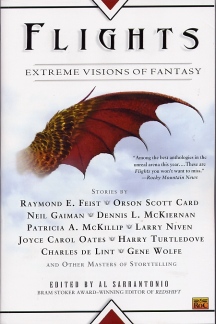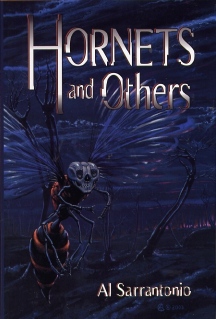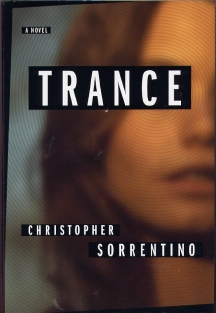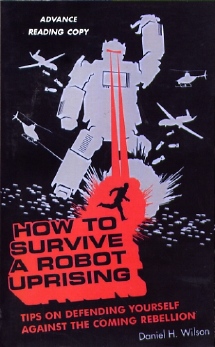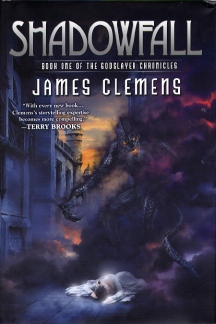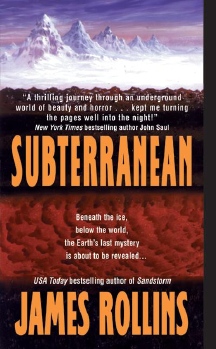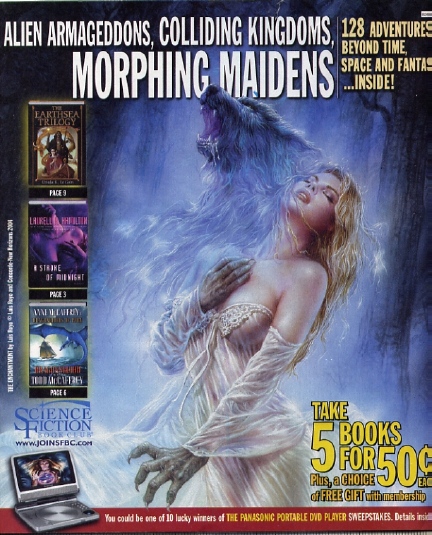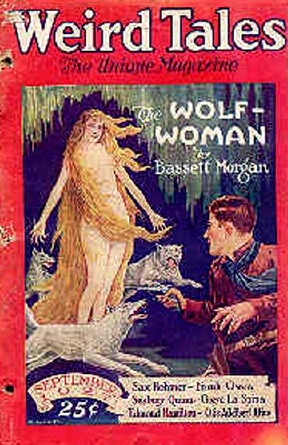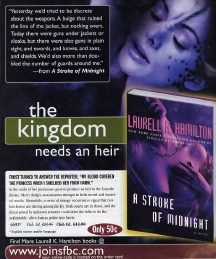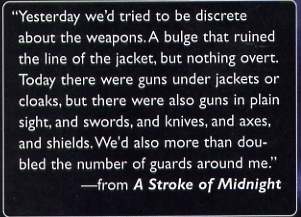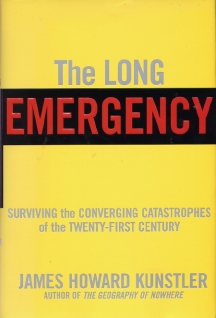|
|
|
This Just In...News from the Agony Column
|
06-24-05: Al Sarrantonio, Editor and Writer |
||||||
'Hornets
and Others' from CD and 'Flights: Extreme Visions of Fantasy'
Fast forward to the present. Out of the blue, I get an email from Mr. Sarrantonio himself, letting me know that he's now working with Hill House Publishing, as they ramp up their activities to match the demand for fantastically well-produced books that they helped to create. Fie on anyone who says that reading is down. Who could give a fig when folks like those at Hill House can take our favorite written works -- you know, just letters on pages, what could be more plain -- and transform those silly letters on pages into read-'em-with gloves works of Art? In the whirlwind follow up to their versions of the Neal Stephenson Baroque Cycle novels and their versions of the Neil Gaiman works, they've found themselves elevated from minor to major stardom. Thus, theyve hired Mr. Sarrantonio to help them keep track of the many amazing projects they've got in the hopper. It's the big-time for a small press publisher. A victory for the forces of fine reading! Then recently, I read about a movie being made about werewolves on the moon and undertook to ask Sarrantonio about it. He told me that, "As for my novel MOONBANE and the movies: there were some nibbles along the way, but nothing at the moment. Rich Chizmar is bringing the book out in a limited hardcover edition sometime in 2005, and after that, who knows?" But we struck up a correspondence, and I've been able to catch up on the many hats of Al Sarrantonio. Having dispensed with the publisher-guy hat above, I can move on to the Editor hat. I was one of many who really enjoyed Sarrantonio's rather daring attempt to raise the anthology bar to 'Dangerous Visions' heights with 'Redshift'. He did a hell of a job facing down an iconic collection and bringing in material every bit as challenging. And in fact, to a certain extent, as much as we loved the original, I suspect that Sarrantonio's collection may age better. The genre itself has found its footing in the intervening years. Of course, the only reason I would write such a line is in the hope that Harlan Ellison -- whom I called on the telephone when I was 14 years old to ask, "Where do you get your ideas?" will unleash some prime venom in my direction. His recent bit about director Stephen Spielberg demonstrates that this is a man who shall never know the wonders of Prilosec! He's still brilliantly cranky, and you've got to love that. Meanwhile, back in the real world of reading, I finally managed to get a copy of Sarrantonio's fantasy-oriented follow-up to 'Redshift', 'Flights: Extreme Visions of Fantasy'. (Roc / Ace / Penguin Putnam ; June 1, 2005 ; $16.00). You can guess where this one is going, and it's a really good place. Given 'Redshift', Sarrantonio used pretty much the formula youd expect to set this anthology up: "Write the best fantasy story you can with no restrictions whatsoever." And that's all you need to know, other than the fact that sixteen bucks puts 500-plus pages of Tim Powers, Neil Gaiman, Jeffrey Ford, Joe R. Lansdale and others in your hand. Trust me, this is not going to be a pocket book even in its eventual MMPB release. What it is going to be is the kind of book that you look forward to every time you open it. How can it not be when you've got 'Bill, the Little Steam Shovel' by Joe R. Lansdale to look forward to? This is the kind of purely pleasurable, totally wonderful reading that makes life worthy of the products from Hill House. And even Peter Schneider, the publisher of Hill House offers a hysterical take on 'Tots'. Do not read while drinking milk, or coffee. Have you ever had hot coffee go out your nose? It's worth experiencing exactly once, heres your chance.
|
|
06-23-05: Christopher Sorrentino Puts You In A 'Trance' |
|||
Hypnotized
by the SLA
I dont know about you, but I sure as hell remember 1974 and whole Patty Hearst kidnapping. Those were tense times, especially in Southern California where six of the SLA eventually died in a firestorm and shootout with the LAPD. There's a certain vibe that I dont think anyone has yet quite caught, at least in fiction, an amalgam of pollution, commercials, overcrowding and mental depression that I associate with those dingy days. But I think that Christopher Sorrentino, in 'Trance' (Farrar, Strauss and Giroux ; July 6, 2005 ; $26) may have managed to do so. He's got the right amount of grit in his prose to take on the rather daunting task of re-telling the tale of our own homegrown terrorists and their sad, violent escapades. And his vision has enough depth to provide a context for their exploits. Sorrentino's first novel was the 1995 title 'Sound on Sound' from the Dalkey Archive Press. It was an ambitious assembly, in which he attempted to create a written analogue of a multi-track recording that documented the rise and fall of Hi Fi, a rock band playing a gig at a seedy New York club. There's a rhythm track that begins the book, written like a screenplay treatment, followed by series of overdubs, which include an evidence-in-a-trial-like list of items and even a "solo" by the Hi Fi aficionado who tells the story. It's certainly not your average rock and roll novel. Sorrentino contributed an article to 'Give Our Regards to the Atomsmashers: Writers on Comics', which includes luminaries like Jonathan Lethem, Aimee Bender and Steve Erickson. Readers can even find a sample of his work at the very intriguing 'Other People's Stories' website. I have to warn you that the website is sort of a time-sink like 'Found' magazine, and chances are you'll be racking your brain to think of your own potential contribution. When you follow the link, don't say you weren't warned. Nice site design as well. With 'Trance', Sorrentino takes on the ostensibly normal novel format in a big-time fashion. What you're getting is a novel of crime fiction written with literary sensibilities. What Sorrentino has done is to fictionalize the events, at least with regards to the character of Patty Hearst, who in the novel becomes Alice Galton. He keeps fairly close track of what happened in reality, but allows himself enough latitude to avoid any legal ramifications of writing about real people who are still living. More importantly, the fictionalization allows him to really get under the skin of the crazy folks he's writing about. Sorrentino is well aware of all the absurdity of the situations his characters find themselves in, and he's able to evoke the humor as well as the horror. This is an important point for me, because while the entire episode is tragic, it's also well, really weird. And kind of funny, if you have a sick sense of humor. Sorrentino writes the kind of impressionistic prose that you need to capture the complexities of a very small world flying apart as if it had been hit by a frying pan, which keeps the novel a nice distance away from Imminent Art Death. At over 500 pages, 'Trance' is something of a reading investment. But it may be the best payback youre going to get out of the whole sordid episode, a layered and gripping look at our tawdry history, our ugly, un-hidden past. No, it wasn't really pleasant to live through those times. But if Sorrentino is telling the story, it may be quite gripping, if not pleasant to read about them. |
|
06-21-05: 'Shadowfall' by James Clemens |
||||||
An
Underground Life
What's at work is that the pivotal impact of China Miéville's 'Perdido Street Station' is finally showing up in domestic hardcover releases. To my mind, it used to be that there was exactly one model for all fantasy, J. R. R. Tolkien's 'Lord of the Rings. This meant that just about any fantasy you saw would involve elves, humans and sorcerers striking out across a forested landscape in search of a token or a weapon that would put evil in its place, for a millennia or so. If you weren't interested in those elements -- and I'm generally not -- then you needn't bother to read the stuff, no matter how competently written it may have been. But now we have a wave of fantasies that feature urban settings, and if there are still evil things in the night trying to TAKE OVER THE WORLD, well, at least they're a bit more tangible and monstrous than a guy in a dark robe waving his hands about. This James Clemens book looks to be a pretty decent example, featuring a lot of elements that I like a lot. Mostly what this boils down to is MONSTERS. And where that starts is on the cover of the book, with a wonderfully dark illustration by Steve Stone. Between the Malazan books and this series, Stone is in the forefront of bringing photorealism to fantasy illustration in a way I find really classy. The bottom line here is that Stone's illustrations are exciting enough to get me to pick up the novel. That's the heavy lifting that publishers want to have happen when they commission the cover art.
The second test is the real test. It's the old flip-into-the-middle-of-the-book-and-see-if-it's-any-good routine. In Clemens, I found myself in the midst of a scene wherein a huge slimy monster is devouring a ship. Rock on, dude! Well written and engrossing. Next time around the more standard-issue pulling-the-arrow-from-his-wound scene. Not so thrilling to this particular monster-hound in light of the first scene, but certainly well-executed. So, it looks like a pretty good deal. But wait -- there's more, much, much more. Why? Because James Clemens, the back of the DJ tells us, is none other than...wait for it...James Rollins, the author of about sixty* (or so it seems) contemporary adventure-horror novels, most of them set underground. Youd have to have hidden from titles like 'Subterranean'. And I know that you havent. [*It proves to be seven.] In fact, if you're like me, you've picked them up and said, "How the hell can he write so many novels so fast?" Or, "Damn, next time I need a monster book, here's what I want." Well, looks like you got it. And I got it. Clemens, Rollins, monsters, underground. Contemporary horror and monsterific fantasy. Let the good times roll. And bring yer own shovel! |
|
06-20-05: Random Thoughts for A Monday Morning; James Howard Kunstler's 'The Long Emergency' |
||||||||||||||
Will They Respect Us Afterwards?
One of the things that happen when you subscribe to science fiction magazines is that someone out there presumes that you're a certain kind of person. You're the kind of person who likes to read.
You're the kind of person who wants to buy lots of books. Well, yes I am. You're the kind of person who wants to read and buy books about "ALIEN ARMAGEDDONS, COLLIDING KINGDOMS AND MORPHING MAIDENS." Um. She needs a manicure, and that's not an observation I make every day. No genre does a better job at designing a hair shirt for its readers than science fiction. Right now, across the nation the parents of the five or so teenage boys who subscribe to F&SF are clutching the Science Fiction Book Club come-on and trying to steady themselves. "At least he's reading, instead of just playing Grand Theft Auto," they're thinking. The wives of the rest of the subscribers have already binned it. Welcome to the world of selling science fiction. It may be the TWENTY-FIRST FRIGGIN' CENTURY, but apparently we' havent progressed much since the heyday of 'Weird Tales' eighty years ago. Science fiction is still stories for boys. Apparently, morphing maidens are our number one concern. After that, it's guns. Lots and lots and lots of GUNS.
Now, I've seen the adverts for the other book clubs. They recognize that WOMEN READ TOO. The Mystery Book Club doesn't present the mystery genre as all Mickey Spillane book covers. The Regular Old Book Club just gets right out and says that every book is That Book. But it doesn't portray That Book as "the sultry search for hot truth about Mary Magdalene." People who read science fiction lead pretty much dignified, normal lives, work regular jobs, eat regular food, and are not prone to morphing themselves. So why presume that theyre going to morph into the kind of person who responds to this sort of advertising?
And next it you can find a Kelly Armstrong two-fer, 'Witch Magic', comprised of 'Dime Store Magic', and 'Industrial Magic'. And next to that 'Everybody Comes to the Nightside', a hardcover compilation of Simon R. Green's 'Something from the Nightside', 'Agents of Light and Darkness' and 'Nightingale's Lament'. "Yours now for 50¢!"
And talk about hair shirts...What do you do when GEORGE LUCAS, stomps on the buildings in the city where you live, lumbers into town and asks you to write a bestseller? George, I'm over here. Over here, its a short walk! I've got NO NAME WHATSOEVER, and I can read an outline. Mathew Stover is a nice a guy, a good writer, he's a made man. How can he recover from writing the dialogue for 'Revenge of the Sith'? Oh the Agony. This is, after all, the Agony Column. I feel your pain, and yet I've kept the brochure. It's strictly professional interest, you understand. Again and again, we're told that nobody ever lost money underestimating the taste of the American public. But there's a first time for everything. And by the way SFBC -- when you send me the free hair shirt, make it's a LARGE. |
||||||||||||||
Hope It's Science Fiction
Required reading, I guess, especially for the science fiction crowd, though presumably, not those who are looking for lots of morphing maidens. Kunstler is the author of three other non-fiction books and nine novels, so he's got both the fact-slapping and page-turning methodologies down. Having heard him speak, I have to say he's got an argument that is pretty compelling. The premise of the 'The Long Emergency' is that THE PARTY'S OVER. This is as good as it gets, folks, and it's all downhill from here. We've used up over half the oil, and now China is going to want in on what's left. The price is going to soar high enough to make today's gouging look positively generous. Suburbia is dead. Over the next three years, things are going to get worse to the point where our government is going to declare the first Emergency. You know, rationing, travel restrictions, some such. But this emergency won't go away and it will get company. And we can all watch the lives we've cherished, the lives we've worked so hard to build go a swirlin' down the toilet. The days of the Big Swirly are upon us. Now, this is not exactly a new notion. Back when I was in high school -- uh oh, dating myself now -- Paul Erlich was writing about the same damn thing, only he figured we'd be crumbly, crispy toast about now instead of a nation of fat cats and downwardly mobile everybody else. But that old "The Apocalypse is just around the corner," argument is always compelling. Of course, the nation's response back then was to lower the speed limit and build smaller cars that got better mileage. That might have something to do with the fact that were still kicking. You think? Whatever you think, it's bound to be stimulated and enhanced by Kunstler's book-length rant. I LOVE a good rant and the darker it is, the more depressing and compressing it is, the more I love it. Readers who want to skirt the line of science fiction and fact will have a hell of time reading bits of this and then engaging those around them in long and bitter arguments. Readers who want to mine a book for story fodder will have to go on a story fodder diet after reading this one. In fact, this book could inspire a whole sub-genre of near-future fiction that publishers will do everything they can to market as mainstream instead of science fiction.
I sure are hell don't want to see any of Kunstler's predictions come true. I'd love to see his work relegated to the realm of Chicken Little. I want to see this book filed under Science Fiction, not Non-Fiction. Kunstler at least helps us in this by providing no footnotes. Who needs footnotes when you've got a picture of a horse pulling a dead automobile? Far as I'm concerned, that takes out at least a thousand words worth of footnotes. One only hopes that it's not us, the reading-the-book, or ignoring-the-book-thankyouverymuch part of the audience, who are in fact the footnotes to the disasters to come. "We've got five years, that's all we've got," David Bowie sang back about the time that Paul Erlich was publishing 'The Population Bomb'. According to Kunstler, he was an optimist. |
